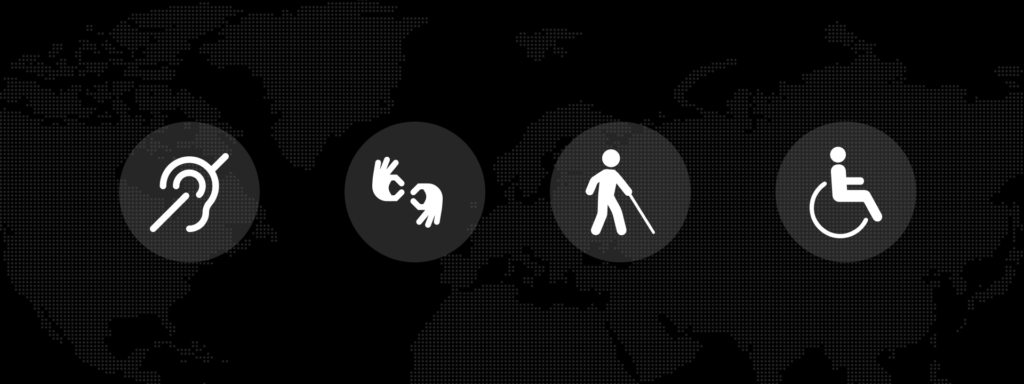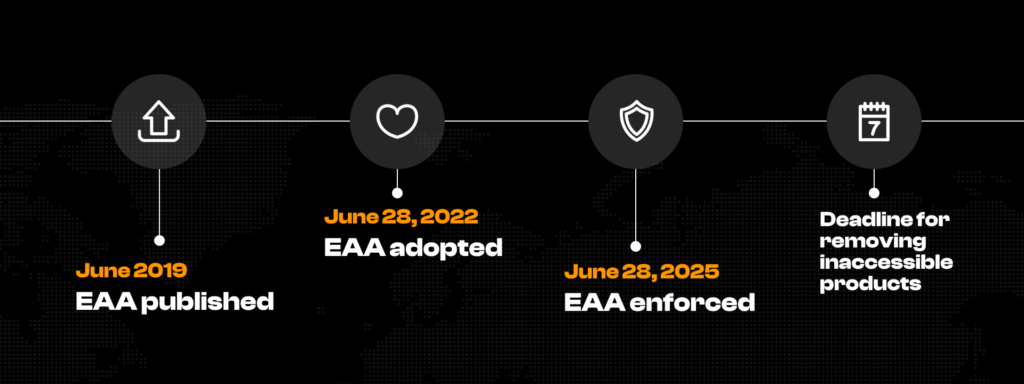Hello and welcome! You’ve probably heard that starting June 28, 2025, the European Accessibility Act (EAA) will change the rules for online shopping. This new law covers e-commerce platforms across all EU Member States. It requires websites and apps to meet the EN 301 549 technical accessibility standard.
Most online stores today do not meet these rules. If you ignore EAA 2025 standards, you risk losing customers and facing heavy fines. So, investing in professional help will save you money and stress later. Keep reading this article to learn more.
IT Delight offers a full accessibility audit for e-commerce and technical support. We help you check your site, resolve existing issues, and ensure compliance.
What is the European Accessibility Act (EAA) 2025?
The European Accessibility Act, also known as Directive (EU) 2019/882, is a law created by the European Union. Its goal is to make products and services more accessible to people with disabilities.

The EAA was adopted in 2019 but became fully enforceable for digital services on June 28, 2025. From this date, all e-commerce websites, apps, and platforms must follow specific accessibility standards.
The law applies to businesses that sell goods or services in the EU, even if they are based outside the EU. It affects many sectors, including:
- Online stores
- Banking sphere
- E-books and reading devices
- Public transport apps and ticketing machines
To follow the EAA 2025, your website or app must meet the EN 301 549 standard. This means your content must be easy to see, hear, understand, and use for everyone, including users with visual, hearing, or mobility impairments. The main goal is simple: make digital products easy for everyone to use, regardless of their abilities.
Who does the European Accessibility Act apply to?
You’ll be affected if your company offers digital products or services to people in the EU. This includes both large companies and small-to-medium enterprises, although microenterprises may be exempt from some rules.
What products and services are covered?
The EAA 2025 focuses on key areas that people use every day:
- Online stores and marketplaces: Your website or app must be accessible for browsing, product search, checkout, and customer support.
- Banking and financial services: Online banking apps, websites, ATMs, and payment terminals must be user-friendly for everyone.
- E-books: Digital books and reading software must allow people with visual impairments to access content.
- Telecommunications services: This includes calling, messaging, and customer support platforms.
- Ticketing and travel information systems: Apps and websites for booking transport must also meet accessibility standards.
If your product or service is digital and widely used, it falls under the EAA. The goal is to remove digital barriers, so people with disabilities can shop, bank, travel, and connect just like anyone else. And for businesses, this means now is the time to act and open their business to more potential customers.
European Accessibility Act Requirements in 2025
Starting June 28, 2025, all covered digital products and services must meet specific accessibility requirements. These rules are based on the EN 301 549 standard and the WCAG 2.1 guidelines, at a minimum, Level AA.

1. Perceivable content
Text must be readable with screen readers
- Images must have alt text
- Videos should include captions and transcripts
- Color should not be the only way to show meaning
2. Operable interface
- All functions (like navigation, search, checkout) must work with a keyboard
- Users must have enough time to read and use the content
- No content should flash in a way that could trigger seizures
3. Understandable information
- Text should be clear and easy to read
- Navigation must be consistent across pages
- Forms must have labels and error messages
4. Robust content
- Your website must work well with assistive technologies (like screen readers or speech recognition software)
- Code must be clean and follow web standards
5. Accessible customer support
- Support channels (chat, email, phone) should be usable by people with different disabilities
- Users must be able to request help in an accessible format
6. Documentation and feedback
- You need to provide an accessibility statement.
- Users should be able to report accessibility issues easily.
- Reminder: These are not optional. If your site doesn’t meet these rules by June 2025, you could face legal action, customer complaints, or fines.
What does the EAA 2025 require from e-commerce websites?
Many popular e-commerce platforms, such as Magento, Shopware, and Shopify, do not fully meet these standards by default. Some themes appear modern but lack the necessary accessible structure.
So even if your store runs on a trusted platform, it doesn’t mean EAA compliance. You’ll need custom adjustments or redesigns to meet the law’s requirements and provide a more inclusive shopping experience.
This is precisely where professional support becomes useful. A generic setup won’t protect your online business from legal risk, but a tailored approach will.
Why is web accessibility so important?
Web accessibility ensures that all users, including people with disabilities, can navigate and interact with digital content without barriers. Without accessible design, many users are excluded from using online services, including online stores. From one perspective, accessibility is a responsibility, but from the other, it is a strategic advantage.

By creating an inclusive user experience, companies like yours can reach a broader audience, avoid hefty fines, improve customer satisfaction, and enhance their brand reputation. However, accessible websites are often easier for everyone, not just people with disabilities! Straightforward navigation, readable content, and well-structured pages benefit all users.
Make your eCommerce site accessible
Acting now allows your business to prepare properly, avoid costly risks, and demonstrate a genuine commitment to inclusion.
Are you prepared for the new EAA legislation?
une 28, 2025, may feel far off. But if your eCommerce business isn’t already considering the European Accessibility Act, now’s the time to start. Getting ready for the EAA isn’t something that can be done fast or overnight. It takes planning, audits, development work, and much testing.
Step #1.
The first step is knowing where you are now. Has your website been tested for accessibility? Does it meet the EN 301 549 standard or WCAG 2.1 AA guidelines? If the response is negative or uncertain, it is appropriate to conduct an accessibility audit. A professional site accessibility audit for e-commerce will find what’s working, what’s missing, and what needs to be fixed.
Step #2.
Once you have that overview, prioritize the changes that impact users the most, like screen reader compatibility, keyboard navigation, and accessible forms. These areas often create the most significant barriers, and fixing them early brings real improvements.
Step #3.
Make accessibility a team effort. Your developers, designers, content creators, and testers must understand the basics of inclusive design. Building accessible features from the start is far easier and less expensive than patching them later.
Sounds overwhelming? You’re not alone. Over half of the websites are not ready for the new European Accessibility Act. IT Delight is committed to providing support at every process stage – from auditing and planning to implementation and ensuring long-term compliance. Start now, stay ahead of the law, and make your store truly welcoming to everyone.
What Happens If You Don’t Comply With The EAA 2025?
Ignoring the European Accessibility Act isn’t risky, it’s costly! If your e-commerce website doesn’t meet accessibility standards, you could face fines, legal actions, or customer complaints. That’s a serious threat to any growing business.

Some countries have penalties for people and organizations that do not follow the rules:
- In Germany, fines can go up to €100,000, depending on how severe the violation is. Germany does not use criminal prosecution like other EU countries.
- In Italy, fines range from €5,000 to €40,000 and can increase for repeat violations or if someone does not cooperate with authorities.
- Not following the rules can lead to significant financial and legal consequences in France, but the exact amounts may vary.
However, the legal side is only part of the problem. A non-accessible site creates real barriers for people with disabilities. And this group is much larger than most companies think, over 100 million people in the EU live with some form of disability. You’re shutting out many potential customers if your site isn’t inclusive.
There’s also a technical advantage to doing things right. Accessible websites are better for SEO. Search engines like Google reward clean code, proper heading structure, image alt text, and user-friendly design -all key parts of accessibility. So by making your site more inclusive, you’re also making it easier to find online.
Conclusion: Prepare Your Store for the New European Accessibility Act
With the 2025 deadline approaching fast, the time to act is now. IT Delight specializes in helping e-commerce businesses meet accessibility standards without compromising design or performance. We offer:
Accessibility Audit
We conduct comprehensive accessibility audits to assess your current website’s compliance with the EU Accessibility Act and WCAG 2.1 standards. You’ll receive a detailed report highlighting issues and a clear improvement roadmap.
Accessible UI/UX Design
Our team creates intuitive, inclusive, and visually appealing UI solutions that ensure everyone can browse and shop easily and comfortably, including users with visual, motor, or cognitive impairments.
Fixing Common Accessibility Issues
We identify and fix common accessibility errors that may hold your store back, such as improper headings, missing alt text, low contrast ratios, and non-keyboard-friendly navigation.
Making your eCommerce site accessible isn’t just about following rules. It’s about welcoming more customers and improving the shopping experience for everyone. Let us help you take that next step toward compliance and inclusivity.
